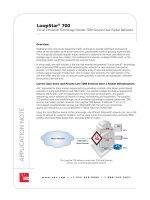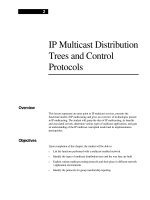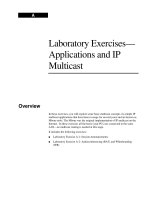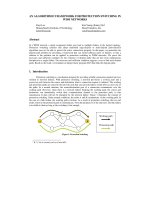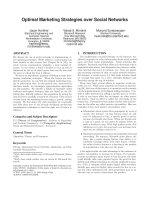IP multicast over WDM networks
Bạn đang xem bản rút gọn của tài liệu. Xem và tải ngay bản đầy đủ của tài liệu tại đây (897.36 KB, 167 trang )
IP MULTICAST OVER WDM NETWORKS
Ding Aijun
(M. Eng, NUAA)
A DISSERTATION SUBMITTED
FOR THE DEGREE OF DOCTOR OF PHILOSOPHY
DEPARTMENT OF COMPUTER SCIENCE
NATIONAL UNIVERSITY OF SINGAPORE
2003
I
ACKNOWLEDGEMENTS
I would like to take this opportunity to thank my supervisor, Dr. Tan Sun Teck, and
ex-supervisor, Dr. Poo Gee Swee. Dr. Tan is a friendly person. He has helped me a lot
in both my research and my life. Dr. Poo continued supervising me unofficially after
he left School of Computing, National University of Singapore. He provided me with
valuable advice to guide me through the whole research course.
I am very glad to have many friends during my course of research. Some of them
have already left Singapore. But the existence of each of them has created a warm
family atmosphere. In particular, I would like to thank Jun He, Jinquan Dai and
Zhengdong Yu for the constructive discussions on research matters. Additional thanks
to Jun He for lending me the powerful PC for my simulations.
I feel deeply indebted to my wife. She is always with me through days and nights,
happy or sad, in Singapore. The life here could be very tough for a young couple,
especially at the time of economic recession. She has suffered a lot from the hard life.
Finally, I am very grateful to my parents. Unlike many Chinese parents, they never
give me any pressure. Instead, they always give me enough freedom to choose my own
way. And yet, they would correct me silently whenever I stray. They have instilled
hope, confidence and perseverance, and that has helped me endure difficult times. Papa
and Mama, you son has finally made it! I dedicate my thesis to you.
II
TABLE OF CONTENTS
Acknowledgements I
Table of Contents II
List of Figures VI
List of Tables IX
List of Tables IX
Summary X
Acronym XII
Chapter 1 Introduction 1
1.1 Multicast in Various WDM Networks 1
1.2 Motivation of Research 3
1.3 Objective of Research 5
1.4 Contributions of Thesis 7
1.5 Organization of Thesis 10
Chapter 2 Review of Related Work 11
2.1 Introduction 11
2.2 Multicast-Capable Optical Switches 14
2.2.1 Splitter and Delivery Switch 14
2.2.2 Capacity and Cost Estimate of Nonblocking Multicast Switches 16
2.3 Multicast in Single-Hop WDM Networks 17
2.3.1 Network Structure 17
2.3.2 Scheduling Algorithm 19
2.4 All-Optical Multicast over Wide-Area WDM Network 21
2.4.1 Multicast Routing over Full Splitting Networks 22
2.4.2 Multicast Routing over Sparse Splitting Networks 23
Protocols based on modification to an existing multicast tree 24
Protocols requiring full knowledge of network 27
Protocols that use powerful nodes as cores 28
2.4.3 Wavelength Assignment 29
2.5 Conclusion 30
Chapter 3 Simulation Methodology 32
3.1 Simulator Design and Implementation 32
3.1.1 Why not ns-2? 32
3.1.2 System Design 32
3.1.3 System Implementation 33
3.2 Simulation Instance Generation 33
3.2.1 Topology Generation 33
The Waxman model 33
Connectivity test 34
Reduction test 34
Cost and delay of edges 34
3.2.2 WDM Network Generation 34
3.2.3 Event List Generation 35
3.2.4 Wavelength Search Scheme 36
3.2.5 Optical Component Deployment Scheme 37
3.2.6 Optical Component Cascading Scheme 37
3.2.7 Simulation Instance Generation 38
3.3 WDM Network Specific Routing Issues 39
III
3.3.1 Multiλ-light-tree 39
3.3.2 Odd Situations 40
3.4 Benchmarking 41
3.4.1 Benchmarking on the I080 Set 42
3.4.2 Test Results on the PUC Set 42
Chapter 4 The Proposed Expanded-Graph Model 44
4.1 Introduction 44
4.2 Definition, Notation and Formulation 45
4.2.1 Network Topology 45
Electronic network 45
WDM network 45
4.2.2 Multicast Group 45
4.2.3 Network Connection 46
Paths 46
Trees 46
4.2.4 Degree Constraint 46
4.3 Graph Representation of the WDM Network 47
4.3.1 Multi-Layer Nature of WDM Networks 47
4.3.2 Layered-Graph Model 48
4.3.3 The Auxiliary-Graph Model 50
4.3.4 Expanded-Graph Model 51
4.4 Routing Heuristic 52
4.5 Simulation 54
4.5.1 Simulation Methodology 54
4.5.2 Simulation Results 55
4.6 Conclusions 60
Chapter 5 The Layered-Routing Approach 61
5.1 Introduction 61
5.2 The Layered-Routing Approach 61
5.3 Development of Heuristics 65
5.3.1 SPH 67
5.3.2 ADH 68
5.4 Simulation 70
5.4.1 Simulation Setup 70
5.4.2 Numerical Results 71
First Part: Comparison of Heuristics 71
Second Part: Blocking Performance 76
5.5 Comparison with the Expanded-Graph Model 81
5.5.1 Comparison of Run Time 82
5.5.2 Comparison of Blocking Performance 83
5.6 Conclusion 84
Chapter 6 Blocking Performance Analysis 86
6.1 Introduction 86
6.2 Blocking Performance Analysis on Adaptive Unicast Routing 88
6.2.1 Notations, Symbols, and Assumptions 88
Network and traffic 88
Symbols and notations 89
Assumptions 90
6.2.2 Analytical Procedure 91
Free wavelength distribution on a single link 91
IV
Free wavelength distribution on a segment 92
Overflow traffic to wavelength convertible queue 92
Blocking probability analysis of a route 94
Selecting probability of a route 94
Blocking probability of the whole network 94
6.2.3 Iterative Algorithm 95
6.2.4 An Adaptive Routing Algorithm 97
6.2.5 Numerical Results 97
Network topology and traffic model 97
Blocking performance 98
6.3 Analytical Model for Fixed Multicast Routing 100
6.3.1 Notations and Assumptions 100
6.3.2 Queuing Network Model for a Node 102
Distribution of busy wavelengths on a single link 102
Distribution of common wavelengths among different links 103
Queuing network model for a relay node 104
Queuing network model for a fork node 105
Usage of the queuing models of nodes 106
6.3.3 Blocking Performance Analysis of the Whole Network 106
6.3.4 Numerical Results 108
Simulation methodology 108
Simulation results 109
6.4 Conclusion 110
Chapter 7 Delay-Constrained Multicast over WDM Networks 113
7.1 Introduction 113
7.2 Review of Related Works 114
7.2.1 Definition, Notation and Formulation 114
7.2.2 Delay-Constrained Offline Multicast Algorithms 115
Naïve approach 115
Two-tree approach 116
Direct approach 116
7.3 Problem Investigation 118
7.3.1 Formal Definition 118
7.3.2 Importance of Graph Transformation 118
7.3.3 Network Model 120
7.4 Proposed Algorithm 120
7.4.1 Graph Transformation 120
Transformation of WIC region 120
Merging with non-wic region 122
Membership transfer 123
7.4.2 Formal Algorithm Description 123
Main flow 124
Multicast routing 125
Wavelength assignment 125
7.5 Simulation 127
7.5.1 Simulation Setup 127
Network topology 127
DCP calculation 128
7.5.2 Numerical Results 128
7.6 Conclusion 132
V
Chapter 8 Conclusion and Future Work 133
8.1 Problem Revisited 133
8.2 Thesis Contributions 134
8.3 Future Work 135
8.3.1 Group Steiner Tree Problem 135
8.3.2 Multicast over Packet-Switched WDM Network 136
8.3.3 Delay-Constrained MCRWA 136
8.3.4 Online Multicast 136
Appendix A. WDM Technology 138
A.1. Brief History of WDM Network 138
A.1.1. Evolution of Optical Fiber 138
A.1.2. Evolution of Optical Fiber Transmission Systems 140
A.1.3. Evolution of Optical Networking 141
A.2. Optical Components 143
A.2.1. Wavelength Converter 143
A.2.2. Light Splitter 144
Author’s Publications 146
Reference 147
VI
LIST OF FIGURES
Figure 1 Taxonomy of WDM networks 1
Figure 2 A proposed L x Q SAD switch by using 1 x Q splitters, optical gates (G) and
1 x 2 switches 14
Figure 3 A proposed OXC architecture employing SAD switch 15
Figure 4 Three multicast models (a) MSW (b) MSDW (c) MAW 16
Figure 5 Star topology 18
Figure 6 An example multicast tree 25
Figure 7 Parent-initiated LSP setup 25
Figure 8 Cascading of splitters and converters 37
Figure 9 Odd situations in optical multicast 40
Figure 10 WDM network, light splitting and wavelength conversion 48
Figure 11 Illustration of the layered-graph model 49
Figure 12 Illustration of the auxiliary-graph model 50
Figure 13 Expanded graph transformation 51
Figure 14 Pseudo-code of the SPH heuristic 53
Figure 15 Blocking performance under the STRIGENT scheme 55
Figure 16 Blocking performance under the CASCADING scheme 56
Figure 17 Average number of hops under the STRIGENT scheme 57
Figure 18 Average number of hops under the CASCADING scheme 58
Figure 19 Blocking probability vs. group size 59
Figure 20 Blocking probability vs. number of wavelengths 59
Figure 21 Quasi-Prim heuristic generic flow 63
Figure 22 Quasi-Kruskal heuristic generic flow 64
Figure 23 The pseudo-code of the SPH heuristic 67
Figure 24 The pseudo-code of the ADH heuristic 69
Figure 25 QoS vs. terminal density (tDense) 73
VII
Figure 26 QoS vs. LS density (lDense) 73
Figure 27 Number of light splitter vs. terminal density (tDense) 74
Figure 28 Number of wavelength converter vs. terminal density (tDense) 74
Figure 29 Blocking probability vs. traffic intensity using different wavelength search
methods 76
Figure 30 Blocking probability vs. traffic intensity with different splitter and converter
deployment scenarios 77
Figure 31 Blocking probability vs. traffic intensity for different cascading schemes 78
Figure 32 Percentage of instances with minimum cost 79
Figure 33 Impact of the number of optical components on blocking probability 80
Figure 34 Impact of converter and splitter density on blocking probability 80
Figure 35 Average run time 82
Figure 36 Blocking performance under different traffic intensity 83
Figure 37 Blocking performance under different wavelength conversion percentages 83
Figure 38 Illustration of segments of route r 90
Figure 39 Birth-and-death process for free wavelength distribution on link l 91
Figure 40 Pseudo-code for adaptive routing 96
Figure 41 NSFNET topology 97
Figure 42 Blocking performance for various number of wavelength converters
(wDense = 30% and W = 4) 98
Figure 43 Blocking performance for various number of wavelengths (wDense = 30%
and C = 8) 98
Figure 44 Blocking performance for various density of wavelength conversion (W = C
= 8) 99
Figure 45 Illustration of fork and relay node 100
Figure 46 Queuing model for a single link 102
Figure 47 Equivalent model for common wavelength distribution among links 103
Figure 48 Relay node model 104
Figure 49 Fork node model 105
VIII
Figure 50 The ARPANET topology 108
Figure 51 Blocking probability for various group size 109
Figure 52 Blocking probability for various number of wavelengths 109
Figure 53 Blocking probability for various number of components 110
Figure 54 Illustration of different graphs 119
Figure 55 Illustration of one drawback of the topological graph 119
Figure 56 Illustration of the WIC region 120
Figure 57 Illustration of WIC region transformation 121
Figure 58 Merge with non-WIC region 122
Figure 59 An example of the flat graph 123
Figure 60 Pseudo-code of the main flow 124
Figure 61 A multicast routing algorithm 125
Figure 62 Wavelength assignment algorithm that makes use of light splitting capability
126
Figure 63 Sample multicast tree 127
Figure 64 Blocking probability vs. number of wavelengths 128
Figure 65 Blocking probability vs. delay coefficient 129
Figure 66 Blocking probability vs. density of wavelength conversion (ξ = 0.8) 130
Figure 67 Blocking probability vs. terminal density (ξ = 0.8) 130
Figure 68 Blocking probability vs. traffic intensity (ξ = 0.8) 131
Figure 69 Group Steiner representation of the WDM network 135
Figure 70 Transmission windows and attenuation characteristics 139
Figure 71 Evolution of optical fiber transmission systems 140
Figure 72 Evolution of fiber-optic transmission from single-span transmission to
optical networking 142
Figure 73 Principal model of wavelength converter 143
Figure 74 Star couplers 144
Figure 75 Principle of resonant coupling 145
IX
LIST OF TABLES
Table 1 Cost comparison of multistage and crossbar WDM multicast networks under
different models (CB-Crossbar, MS-Multistage) 17
Table 2 Parameters of the WDM network and their meaning 35
Table 3 Parameters of simulation instance and their meaning 39
Table 4 Benchmarking against PUC instances 42
Table 5 The value fields of the parameters 70
Table 6 Failed instances (number in brackets indicates the number of network
instances tested) 71
Table 7 Companion data table for Figure 30 78
Table 8 Taxonomy of multicast algorithms 113
Table 9 Parameters of simulations 127
X
SUMMARY
Multicast is a useful network service which aims to provide efficient
communication services for applications that send data to multiple recipients. IP
multicast is a receiver-based concept, and the sender does not need to maintain a list of
receivers. Future multimedia group applications, such as video conferencing,
interactive gaming, and network storage require huge bandwidth, and involve group
communication. Multicast provides an efficient and economical way to employ
bandwidth and network resources while the wavelength division multiplexing (WDM)
technology provides huge bandwidth. The combination of multicast and WDM is
critical for the future optical Internet.
Generally, there are three kinds of WDM networks, namely, wavelength-routed
networks, broadcast-and-select networks, and packet-switched networks. Currently, a
few algorithms have been developed to support multicast over each kind of networks.
These algorithms are to be reviewed in this thesis.
We consider multicast over wavelength-routed networks. Previous works done in
this area suffer a number of drawbacks. The most serious two are: 1) they assume
infinite light splitting and wavelength conversion capabilities, and 2) they divide the
problem into two sub-problems: multicast routing and wavelength assignment, and
tackle them individually. The first drawback renders the algorithms useless to real
WDM networks which have only finite capabilities. The second drawback results in
inefficient routing results, as it does not consider routing and wavelength assignment
as one unified problem.
To overcome the shortcomings, we develop an expanded-graph model to transform
a WDM network into a graph, and then apply existing Graph Theory algorithms on the
graph. Compared with other models, the expanded-graph model simplifies the
XI
resulting graph significantly.
To further reduce computational complexity while maintaining a certain level of
quality in the solution, we develop a layered-routing approach. The approach
corresponds to the multi-layer nature of a WDM network. To facilitate algorithm
development, we propose two generic algorithm frameworks. This allows any
algorithm that is derived from either Prim or Kruskal to be easily imported to solve the
problem.
Both methods can complete multicast routing and wavelength assignment in one
phase. Network status is considered at the time of routing. Moreover, the methods are
general enough for use in any kind of wavelength-routed networks. In particular, they
can deal with those networks with finite light splitting and wavelength conversion.
This is the first time that networks with finite capabilities are studied. The results
should help network architects and engineers in designing an optical network.
We simulate all our proposed algorithms and measure their performance. In
addition, we develop two analytical models – one for adaptive unicast routing and the
other for fixed multicast routing. Both models are based on the queuing network
theory, and their distinctive feature is that they take limited capabilities into
consideration, which significantly increases the difficulty of analysis.
Finally, we also consider delay-constrained multicast over a WDM network. We
anticipate the need for QoS routing in future in fast-speed WDM networks.
XII
ACRONYM
ADH Average Distance Heuristic
ARPANET Advanced Research Projects Agency NETwork
ATM Asynchronous Transfer Mode
DCP Delay-constrained least-Cost Path
DCSP Degree-Constrained Steiner Problem
DWDM Dense Wavelength Division Multiplex
EDFA Erbium-Doped Fiber Amplifier
GMPLS Generalized MultiProtocol Label Switching
GSMP Generalized Switch Management Protocol
MCRWA MultiCast Routing and Wavelength Assignment
IP Internet Protocol
LAN Local Area Network
LCP Least-Cost Path
LDP Least-Delay Path
LP Linear Programming
LS Light Splitting
LSP Label-Switched Path
MAC Media Access Control
MAN Metropolitan Area Network
MPLS MultiProtocol Label Switching
MAW Multicast with Any Wavelength
MSDW Multicast with Same Destination Wavelength
MST Minimum Spanning Tree
MSW Multicast with Same Wavelength
XIII
OBS Optical Burst Switching
OLS Optical Label Switching
OXC Optical CrossConnect
PSC Passive Star Coupler
RAM Random Access Memory
RPF Reverse Path Forwarding
SMT Steiner Minimum Tree
SPG Steiner Problem in Graphs
SPH Shortest Path Heuristic
VS Virtual Source
WADM Wavelength Add/Drop Multiplexer
WAN Wide-Area Network
WC Wavelength Conversion
WDM Wavelength Division Multiplex
WIC Wavelength InConvertible
Chapter 1 Introduction
1.1 Multicast in Various WDM Networks
The first laser was invented in 1958 [5] [43]. At that time, engineers and scientists
were already aware of the tremendous potential of optical communication. However,
the exploration in the early days was hard and slow. The breakthrough came in the
early 1990s, when Erbium-Doped Fiber Amplifiers (EDFAs) became commercially
available. For the first time in history, optical signals could be directly amplified in the
optical domain. With that, the Wavelength Division Multiplexing (WDM) technology
finally took off.
Following years of evolution, modern WDM networks may be classified as shown
in Figure 1. The techniques to support multicast over each kind of network vary. We
briefly touch on them here, and present them in detail in Chapter 2.
Broadcast-and-Select
(PSC-based)
Wavelength-routed
(circuit-switched)
Packet-switched
Single-hop
Multi-hop
OLS
OBS
Figure 1 Taxonomy of WDM networks
The broadcast-and-select network centers on a shared medium, usually, a passive
star coupler (PSC). Thus, it is sometimes called the PSC-based network. The physical
topology of the broadcast-and-select network is usually a star, but it can also be a bus
Chapter 1 Introduction 2
or a tree [16][17]. Broadcast-and-select networks have two logical topologies: single-
hop or multi-hop, and are used mainly as LAN/MAN. The difference in logical
topology differentiates single-hop networks from multi-hop ones.
Nodes in single-hop networks are normally equipped with tunable transceivers. A
successful transmission requires fast tuning of either the transmitter or the receiver or
both. Hence, the cost of agile transceivers and the scheduling involved is high. On the
other hand, multi-hop networks aim to alleviate cost by using low-cost fixed
transceivers. Multi-hop networks usually adopt regular logical topologies, such as
ShuffleNet, Hypercube, or Manhattan Street Network [17]. A logical topology is
almost static; it does not change unless the change is beneficial.
However, the single-hop structure makes more sense for multicast transmission
because the star coupler is equipped with intrinsic multicast, or more precisely,
broadcast capability. Therefore, almost all existing works deal with multicast over
single-hop networks. The key is to design an efficient media access control protocol to
schedule transmission and the tuning of transceivers [3][16].
Optical packet switching technology is still in its infancy. The key techniques to
enable packet switching, such as optical RAM, and quantum computing, are far from
being practical. Currently, a few interim substitutes have been proposed, such as
Optical Label Switching (OLS) [35] and Optical Burst Switching (OBS) [58][59].
Basically, OLS uses the sub-carrier multiplex technique [92] to carry labels together
with data packets so as to facilitate instant switching. On the other hand, OBS
assembles data packets into larger bursts and then transfers each burst after a control
packet, which reserves resources along the route for the burst. Multicast over OBS has
been studied [58][59]. The problem of multicast over OLS can be solved in the
framework of GMPLS.
Chapter 1 Introduction 3
However, all the above networks are out of our scope. Our target is to support
multicast over wavelength-routed networks. These networks usually serve as WANs,
and adopt the mesh topology. They rely on wavelength for routing. Therefore, the
interim optical switches must know the relationship between the wavelength and the
routing decision in advance. So a virtual circuit has to be established before real data
transmission begins. In this sense, we view the wavelength-routed network as one kind
of circuit-switched network.
Different from an electronic network where each physical cable can support only
one channel, multiple channels can be supported in a single fiber in a WDM network.
Each channel resides on one wavelength. A new problem – wavelength assignment – is
raised, in addition to multicast routing. Therefore, multicast over WDM involves two
sub-problems: routing and wavelength assignment. The problem is often called the
multicast routing and wavelength assignment (MCRWA) problem. This is the topic of
this thesis.
1.2 Motivation of Research
With the rapid increase in computational power and network bandwidth,
applications have become more and more reliant on multimedia representation and
group collaboration. For instance, a remote medical system, which brings doctors all
over the world together, needs a huge bandwidth to transmit medical images. Most of
the images will be uncompressed and huge in volume, as compression may damage
them. Such multimedia group applications and other future applications require huge
bandwidth, and an efficient method of utilizing bandwidth needs to be developed.
Multicast is a good and natural choice.
To enjoy the benefits of WDM multicasting [90], light splitting and wavelength
Chapter 1 Introduction 4
conversion capabilities must be fully deployed. Both capabilities are unique to the
WDM network. By using light splitting, the time-consuming and expensive packet
copying procedure in the electrical domain is substituted by quick and cheap light
splitting in the optical domain. By using wavelength conversion, the blocked path can
be detoured to a different wavelength. Hence, blocking performance is improved.
Wavelength-routed networks can be classified using various criteria. In terms of
light splitting capability, they can be classified into two groups: one with full light
splitting, and another with finite light splitting. The criterion is the percentage of the
nodes that have light splitting capability. Similarly, networks can also be grouped
according to their wavelength conversion capability.
For multicast over full splitting networks, the problem is divided into two sub-
problems: multicast routing and wavelength assignment. The multicast routing sub-
problem is usually tackled by using Steiner Minimum Tree (SMT) heuristics [29]
while the wavelength assignment sub-problem is generally modeled as a graph-
coloring problem [36]. Usually, wavelength continuity constraint is imposed onto
wavelength assignment; that is, no wavelength conversion is allowed anywhere.
In general, there are three approaches to multicast over sparse splitting networks.
These approaches will be elaborated in Chapter 2. These approaches suffer from a few
problems, and two of them are serious and of general concern.
First, the approaches usually divide the problem into two parts: multicast routing
and wavelength assignment, and then tackle them individually. The two-phase scheme
is not efficient as the routing decision is made without considering network utilization
status. Therefore, a multicast tree may not be successfully embedded into the network,
especially when the network is heavily loaded.
Second, the approaches only consider the networks with infinite light splitting and
Chapter 1 Introduction 5
wavelength conversion capabilities. However, due to various restrictions such as cost,
technique and so on, WDM networks only have finite capabilities in real situations.
Ideally, our proposal should overcome as many problems as possible while
maintaining a high level of performance. Our basic idea is to transform WDM
networks into appropriate graphs, and then apply Graph Theory algorithms to solve the
problem. The graph transformation method, together with Delay-Constrained Steiner
Problem (DCSP) heuristics (cf. Section 4.3.4), helps complete multicast routing and
wavelength assignment in one phase, and successfully address the finite nature of
WDM networks. We develop and propose a few approaches [2][4], and will discuss
them in detail later.
In addition, we attempt to solve delay-constrained multicast over WDM networks.
With the development of network applications, we anticipate the need for such QoS
multicast in the future.
1.3 Objective of Research
In a broad sense, multicast is a kind of group communication, either one-to-many,
or many-to-many, or many-to-one. In this thesis, we consider multicast as one-to-many
communication, i.e., selective broadcast. Typical IP multicast has three parts: multicast
addressing, group membership management, and multicast routing. Our focus is on the
multicast routing problem. Moreover, we will only consider multicast over
wavelength-routed WAN. The final receivers are, of course, in their relevant LAN.
Finally, once the signal enters the WAN, it remains in the optical domain before it
finally exits the network. That is to say, all-optical transmission is required.
Multicast over WDM networks has benefited much from the light splitting and
wavelength conversion capabilities of the WDM network. Hence, our transformation
Chapter 1 Introduction 6
method must be able to produce graphs which correctly represent both capabilities,
especially when the capabilities are finite. Finiteness has different meanings at
different levels. At the network level, it means that not all the nodes have light splitting
and/or wavelength conversion capability. At the node level, a node may not have an
infinite number of light splitters and/or wavelength converters. At the component level,
a light splitter or a wavelength converter has only finite capability. Finiteness at the
first two levels is easy to deal with. To tackle finiteness at the component level, we
introduce the degree-constrained Steiner problem.
Generally, Graph Theory algorithms are sensitive to the number of nodes and edges
in a graph. Computational overhead increases fast with the number. Algorithms that
operate on the whole transformed graph can generate high-quality solutions, however,
at the cost of high computational complexity. Hence, we need to create another
approach that runs faster by sacrificing a little in the quality of the solution. The
approach is expected to make use of the multi-layer nature of the WDM network.
Routing approaches can be divided into three categories: static, alternate and
dynamic [7] [36]. We prefer the dynamic routing approach. It outperforms other
approaches because the routing decision is made after taking network utilization into
consideration.
In conclusion, the objective of our research is to support offline multicast over
WDM networks with finite light splitting and wavelength conversion capabilities by
using the dynamic routing approach. We seek to do the following in our study:
z Complete multicast routing and wavelength assignment in one single step.
z Deal with situations where the network has finite light splitting and
wavelength conversion capabilities.
z Create an effective method for transforming any WDM network into one single
Chapter 1 Introduction 7
graph. Then modify Graph Theory algorithms and apply them on the resultant
graph.
z Find an alternate fast approach which operates on partial network once. In
other words, only part of the graph is used for routing purpose. Hopefully, the
quality of the solution will not degrade significantly.
z Test the performance of all algorithms by means of simulation. Conduct
theoretical analysis of simple cases.
z Optionally, keep the proposed algorithms general enough for any wavelength-
routed networks.
1.4 Contributions of Thesis
In the remainder of this thesis, we will investigate the problem of multicast over
WDM networks. In total, we will develop the expanded-graph model and the layered-
routing approach. Under the model, any WDM network can be transformed into a
graph, and then the relevant Graph Theory algorithms can be applied to it with minor
modifications. By the layered-routing approach, we will reduce computational
complexity by sacrificing some quality of the solution. Using the approach, we will
design two generic algorithm frameworks to provide guidance for modifying existing
algorithms and applying them to solve the MCRWA problem. We will also conduct
intensive simulations to test the performances. The simulation results will reveal the
relationship among various parameters, such as the number of wavelengths, light
splitting capability, and so on, and can be used to guide the design of a real optical
network. Our contributions are listed below in detail.
z We develop the expanded-graph model, which is able to transform a WDM
network into a graph. The transformation method is general, provided the
Chapter 1 Introduction 8
WDM network adopts the share-per-node scheme [50]. Under the scheme, the
splitters and converters of one node are shared among all the connections at
that node. The model is capable of completing multicast routing and
wavelength assignment simultaneously. The resultant graph of our model is
much simpler than that generated by the auxiliary-graph model [50].
z DCSP heuristics must be modified slightly before being applied to the graph
generated by our model. We modify the Shortest Path Heuristic (SPH) [29] as
an example. We test it on real WDM networks for blocking performance. By
real, we mean that the network has only finite splitting and conversion
capabilities. The simulation results show the blocking performance of optical
networks under various constraints.
z The algorithms on the transformed graph are of high computational complexity
because the graph has a large numbers of nodes and edges, and the DCSP
heuristics are sensitive to those numbers. Therefore, we develop a layered-
routing approach by utilizing the multi-layer nature of the WDM network.
Computational complexity is reduced at the cost of marginal degradation of the
quality of the solution. The approach completes routing and wavelength
assignment in one phase.
z Using the layered-routing approach, we develop two generic algorithm
frameworks to facilitate the use of graph-theory algorithms. The frameworks
are the quasi-Prim framework and the quasi-Kruskal framework. They are
capable of importing, respectively, the Prim and Kruskal algorithm families
into the approach. In particular, we have already modified the following
algorithms: naïve, SPH and its variants, K-SPH, and Average Distance
Heuristic (ADH). The prototypes of the algorithms can be found in
Chapter 1 Introduction 9
[29][66][78]. The simulations are conducted over real WDM network to reveal
the relationship between blocking performance and various characteristics of
the network.
z Adaptive unicast routing is analyzed theoretically using queuing network
theory. As WDM networks have only limited wavelength conversion
capability, blocking happens not only at the links as in all other works
encountered, but also at nodes. We propose an iterative algorithm to analyze
overall blocking performance.
z Fixed multicast routing is analyzed theoretically as well. Compared with
unicast, limited light splitting capability is added in. Here, on-tree nodes are
modeled using several complex queuing networks. Blocking performance is
deduced using our iterative algorithm.
z We conduct the first survey of multicast over WDM networks. The survey
covers multicast over most popular network types: single-hop, and
wavelength-routed. Various proposals on routing and wavelength assignment
are investigated. The properties of multicast-capable switches are studied as
well.
z To the best of our knowledge, we are the first to study the MCRWA problem
over WDM networks with finite capabilities. By studying the practical WDM
network, we seek to provide valuable guidelines for network design and
configuration.
z We study delay-constrained multicast over dense WDM networks. A graph
transformation method, which is based on the concept of the WIC region, is
proposed. By transforming WDM networks to flat graphs using our method,
abundant existing algorithms can then be used after minor modifications.
Chapter 1 Introduction 10
1.5 Organization of Thesis
The rest of this thesis is organized as follows. Chapter 2 presents a detailed survey
of multicasting over various WDM networks, and investigates the pros and cons of
various proposals. Chapter 3 introduces the simulation methodology that is applicable
to all simulations conducted in the thesis. Chapter 4 introduces the expanded-graph
model. The modified SPH algorithm is simulated and the results are presented as well.
Section 4.2 provides the definitions, notations and formulations used in the thesis.
Chapter 5 presents the simplified layered-routing approach. Two generic algorithm
frameworks are presented, together with the algorithms developed under the
frameworks. The approach is compared with the model, and guidelines are given to
help make a choice. Chapter 6 presents the analytical models for analyzing blocking
performance in WDM networks. Chapter 7 touches on delay-constrained routing over
WDM networks. Chapter 8 concludes the thesis, and indicates the directions for future
work. Appendix A includes brief technical issues on WDM and IP over WDM.
Chapter 2 Review of Related Work
2.1 Introduction
The concept of multicast has been widely studied in traditional packet-switched
networks. Multicast applications, such as multimedia conferencing, medical imaging,
and digital audio demand huge bandwidth support. Advancements in WDM
technology have provided the availability of enormous bandwidth (about 30THz [16]).
It is natural to extend the multicast concept to optical networks in order to gain
enhanced performance.
Multicast can be supported at many layers. First, at the hardware layer, multicast
capability can be built inside optical switches and other devices. Second, multicast can
be supported at the WDM layer to take advantage of the light splitting capability of
optical switches. Third, multicast can be run at the IP layer. If all optical routers
(switches) understand IP protocol, then most of the IP multicast protocols can be
applied without modification. However, this scheme does not take the special
characteristics of WDM networks into account. So it may be low in efficiency. Finally,
multicast can be supported at higher layers, such as in some reliable multicast
protocols.
The final target of optical network evolution will be pure packet switching.
However, restricted by technology, the wavelength-routed network, which is similar to
the circuit-switched network, forms the majority. Multicasting over wavelength-routed
networks requires the reservation of a wavelength at each branch of the multicast tree
(or forest). It is suitable for high bandwidth multicast applications with relatively long
duration. Wavelength-routed networks usually adopt the mesh topology, and serve as
WAN.


